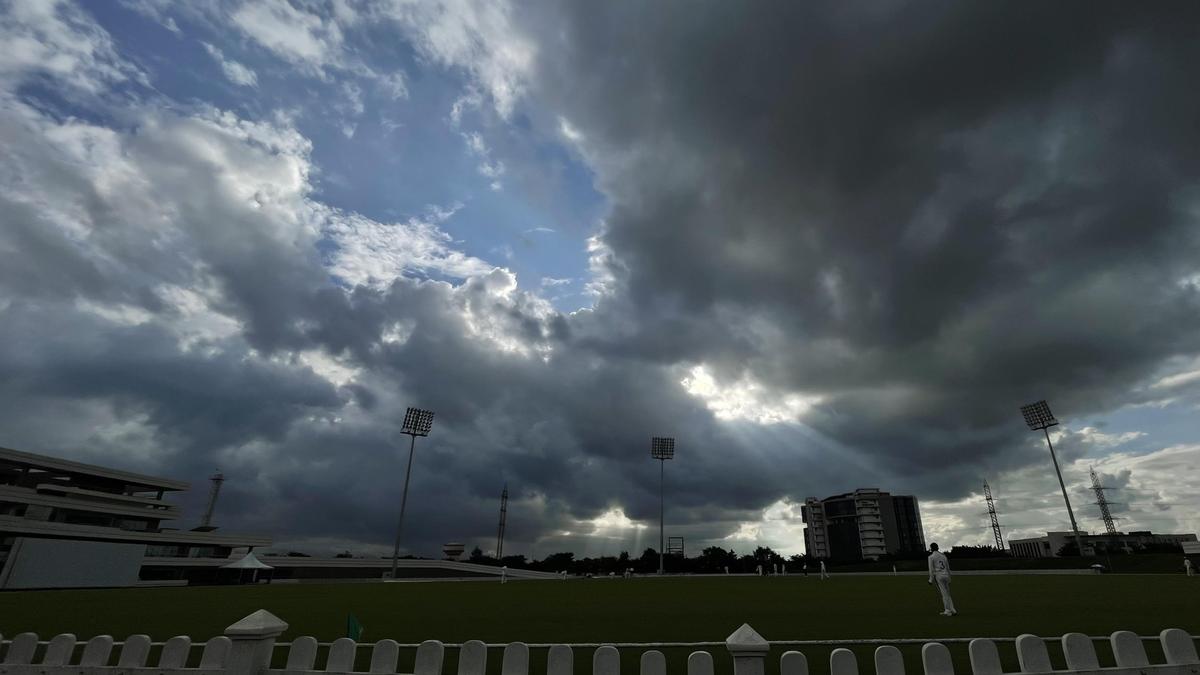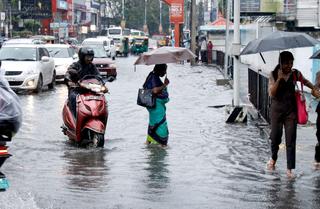Karnataka has been placed on high alert as the India Meteorological Department (IMD) issued a yellow warning for 11 districts following the formation of Cyclone Montha over the Bay of Bengal. The cyclone, currently moving northwestward, is expected to bring heavy rains, strong winds, and thunderstorms to several regions of the state over the coming days. The affected districts include Dakshina Kannada, Udupi, Uttara Kannada, Shivamogga, Kodagu, Hassan, Chikkamagaluru, Bengaluru Rural, Tumakuru, Chitradurga, and Davangere. Authorities have advised residents to remain cautious and avoid unnecessary travel.
With rainfall intensifying across several districts, the Karnataka State Disaster Management Authority (KSDMA) has been working closely with district commissioners to monitor real-time weather data and ground conditions. Control rooms in each affected district are operating round-the-clock to respond to distress calls and coordinate relief efforts. The government has also directed local officials to stock sandbags and water pumps in flood-prone areas, particularly in the coastal belt, to mitigate the risk of flash floods and waterlogging in residential zones.
In Mangaluru and Udupi, the local administrations have urged citizens to avoid venturing near open drains and low-lying bridges. Police personnel have been deployed to manage traffic and prevent accidents on slippery roads. In Kodagu, coffee planters have expressed concern over the heavy rains damaging both crops and drying yards. Agricultural officers have been visiting plantations to assess potential losses and provide guidance on preventive measures. The state has also planned to dispatch relief funds in case of significant damage reports.
Meanwhile, Bengaluru has witnessed moderate showers, accompanied by thunder and strong winds in several areas. The Bruhat Bengaluru Mahanagara Palike (BBMP) has activated emergency teams to clear fallen trees and unclog stormwater drains. Civic authorities have also issued advisories warning citizens to stay indoors during peak rainfall and avoid parking vehicles under large trees or electric poles. The Bangalore Electricity Supply Company (BESCOM) has readied additional personnel to respond to power disruptions.
The Karnataka Power Transmission Corporation Limited (KPTCL) has assured that power infrastructure in vulnerable areas is being monitored continuously. Engineers are on standby to handle transformer failures or snapped lines, which often occur during heavy downpours. In the past, storm-induced outages have disrupted communication networks, so telecom companies have also been asked to keep backup power systems functional to maintain connectivity. This is particularly crucial for remote rural areas where communication lines are often limited.
Agriculture and Rural Preparedness
The Department of Agriculture has set up field monitoring units to provide immediate support to farmers affected by heavy rain. Extension officers have been directed to record crop damage and recommend compensatory measures under state and central insurance schemes. The government has also urged farmers to shift harvested produce to elevated storage areas and secure livestock. In hilly regions like Chikkamagaluru and Hassan, agricultural experts have warned that landslides and runoff could wash away topsoil, affecting coffee and spice plantations.
In the coastal and Malnad regions, paddy fields are at risk of flooding. To prevent complete crop loss, the authorities have advised early harvesting in areas forecasted to receive heavy rainfall. The Horticulture Department has issued alerts to fruit and vegetable growers to take preventive steps against fungal diseases that thrive in damp conditions. Experts have stressed the importance of using protective coverings and maintaining proper drainage in farms. Rural communities have also been encouraged to store dry food and clean water supplies in anticipation of temporary isolation during severe weather.
Public Awareness and Communication
To ensure public safety, the state has intensified its awareness campaigns. Mobile vans equipped with loudspeakers are circulating in vulnerable areas to broadcast weather warnings in Kannada and regional dialects. The IMD’s alerts are being shared through the ‘Varunamitra’ app, which provides live rainfall updates, flood forecasts, and emergency contact numbers. Social media platforms are being used by the government to counter misinformation and provide verified updates. Officials have urged people not to circulate unverified videos or panic-inducing messages.
In educational institutions, awareness sessions on disaster preparedness are being conducted. Teachers are instructing students on emergency protocols, such as how to respond to flooding and electrical hazards. Schools in Kodagu and Dakshina Kannada have temporarily postponed outdoor activities until the alert is lifted. NGOs and community groups have joined hands with local administrations to assist in setting up shelters and distributing food kits in low-lying villages.
The Health Department has also stepped in to prevent post-rain illnesses. Health officers have been deployed to monitor potential outbreaks of vector-borne diseases like dengue, malaria, and chikungunya, which often rise after heavy rainfall. Drinking water sources are being chlorinated, and mobile health units have been dispatched to rural areas. The department has advised people to boil water before consumption and maintain hygiene to prevent gastrointestinal infections.
Forecast and Long-Term Implications
Meteorologists expect Cyclone Montha to weaken gradually after landfall, but warn that Karnataka could continue to receive scattered rainfall for several days due to the trailing moisture bands. The KSNDMC has cautioned that another low-pressure system could form in the Bay of Bengal next week, potentially extending the wet spell. Experts have suggested that such frequent cyclonic activities are indicators of changing climate patterns that require adaptive infrastructure and long-term planning.
Economists and policy analysts have called on the government to review the disaster mitigation framework, citing the growing frequency of extreme weather events in Karnataka. They have emphasised the need for investments in resilient roadways, improved urban drainage systems, and early warning technologies. Environmentalists have further highlighted the necessity of protecting natural wetlands, which act as buffers during heavy rainfall, and restoring mangroves along the coast to reduce storm surge impact.
As the situation unfolds, the collective response from citizens, officials, and emergency services will determine the state’s resilience. With clouds thickening and winds intensifying, Karnataka stands prepared yet cautious. The coming days will reveal the true extent of Cyclone Montha’s influence — a reminder of nature’s power and the importance of preparedness in an era of growing climatic uncertainty.
According to the IMD, Cyclone Montha intensified from a deep depression late on Sunday night and is expected to make landfall near the Andhra Pradesh–Odisha coast within the next 48 hours. Though Karnataka is not in the direct path of the cyclone, its outer bands are likely to bring widespread rain and gusty winds, particularly in the coastal and Malnad regions. Meteorologists have also predicted moderate rainfall in interior parts of the state, including Bengaluru, over the next three days.
Chief Minister Siddaramaiah chaired an emergency meeting with officials from the Revenue and Disaster Management Departments to review preparedness measures. District administrations have been instructed to activate control rooms, deploy disaster response teams, and ensure availability of emergency supplies in vulnerable areas. The Chief Minister emphasised that precautionary steps must be taken in advance to avoid loss of life or property. “We cannot underestimate the threat, even if it’s an indirect impact. Every life matters,” he said.

Coastal Districts Brace for High Tides and Flood Risks
Along the coast, high tides and strong winds have already been reported in parts of Mangaluru and Udupi, prompting fishermen to suspend operations. The Department of Fisheries has issued an advisory prohibiting deep-sea fishing until further notice. Coastal villages have been urged to move boats and nets to safer grounds. District authorities have also warned tourists to stay away from beaches and riverbanks, as tidal surges could occur unexpectedly.
In Dakshina Kannada, officials have begun clearing stormwater drains and removing obstructions from canals to prevent urban flooding. NDRF and SDRF teams have been put on standby in low-lying areas such as Ullal, Surathkal, and Mulki. Udupi district officials have identified temporary shelters in schools and community halls in case of evacuation. The local administration is also coordinating with hospitals to ensure medical support in emergencies.
The IMD has cautioned that wind speeds could reach 50 to 60 kmph in coastal and hilly areas, with isolated gusts exceeding 70 kmph. Such conditions could cause damage to weak trees, power lines, and temporary structures. Residents have been urged to secure loose objects and stay indoors during heavy rainfall. Power utilities have been instructed to prepare for potential outages and mobilise repair crews for quick restoration.
Government Steps Up Precautionary Measures
The state’s Disaster Management Authority has begun disseminating alerts through radio, SMS, and public address systems in vulnerable districts. Farmers have been advised to delay harvesting of crops, particularly paddy and maize, to prevent losses due to rain and strong winds. The Agriculture Department has also issued advisories on protecting livestock and storing harvested grains safely. In hilly districts such as Kodagu and Chikkamagaluru, forest officials have warned about the possibility of landslides and advised residents to remain vigilant.

Transport departments have been directed to monitor road conditions and restrict movement in landslide-prone zones. State transport buses are being rerouted in certain areas where heavy rain is expected to cause flooding. The Public Works Department has deployed machinery and personnel for clearing debris and repairing damaged roads. Educational institutions in some districts have been given discretion to close if conditions worsen.
Officials from the Karnataka State Natural Disaster Monitoring Centre (KSNDMC) have stated that the next 48 hours will be critical in determining the severity of the cyclone’s impact on the state. They have also emphasised that Cyclone Montha could trigger intense weather patterns even after landfall, depending on how the system interacts with the southwest monsoon currents. The public has been urged to rely only on official weather updates and avoid rumours on social media.
Emergency helplines have been set up across all 11 districts, and medical teams have been deployed in coordination with local health departments. Hospitals have been instructed to keep ambulances ready for emergencies. In several taluks, revenue officials are conducting door-to-door awareness drives, especially in areas near rivers and lakes that are prone to flash floods. Officials are also working with Gram Panchayats to identify vulnerable families for possible relocation if the situation worsens.
The Education Department has directed schools and colleges in coastal districts to remain on alert. If rainfall intensity increases, physical classes may be suspended, and online sessions could be introduced temporarily. Officials have also appealed to citizens to avoid venturing out for non-essential purposes, particularly during the night when visibility is poor and roads may become slippery or flooded.
Meteorologists believe that the effects of Cyclone Montha could continue until the end of the week, with gradual reduction in rainfall after the system weakens inland. While Bengaluru and other interior districts may experience moderate showers and cloudy skies, the coast and Western Ghats are expected to bear the brunt. Lightning and thunderstorm activity may also intensify during evening hours, making caution essential.
Economists have expressed concern about the potential impact of heavy rains on agriculture and transport. Coastal Karnataka is a key hub for logistics and fisheries, and disruptions due to weather could affect local trade. Farmers are particularly worried about standing crops that are ready for harvest, as heavy rain can cause waterlogging and spoilage. The government has promised to assess crop damage and offer compensation where necessary.
Environmentalists have highlighted that extreme weather events such as Cyclone Montha underscore the growing unpredictability of climate patterns in South India. They argue that urban expansion, deforestation, and poor drainage systems are worsening the effects of heavy rainfall. Experts have called for better long-term planning, including restoring natural waterways, strengthening coastal defences, and enforcing strict zoning laws in flood-prone areas.
As Karnataka braces for Cyclone Montha’s impact, the focus remains on readiness and resilience. From coastal communities to inland districts, the state’s response will be a test of coordination between agencies and public cooperation. For now, as dark clouds gather over the horizon and winds begin to rise, Karnataka stands watchful — hoping preparation will be enough to weather yet another test from nature.
Follow: Karnataka Government
Also read: Home | Channel 6 Network – Latest News, Breaking Updates: Politics, Business, Tech & More

